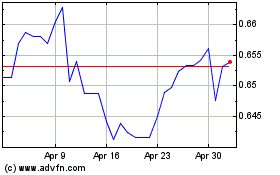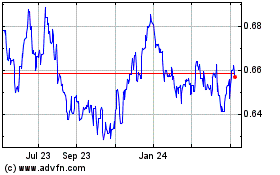German Economy Shrinks In Q3 On Weak Exports, Car Sales
November 22 2018 - 9:52PM
RTTF2
Germany's economy shrunk for the firs time since early 2015 and
at the fastest pace in nearly six years, mainly due to weak exports
and car sales, latest figures from the Federal Statistical Office
confirmed on Friday.
Gross domestic product declined a seasonally and
calendar-adjusted 0.2 percent quarter-on-quarter in the three
months to September, after expanding 0.5 percent in the second
quarter.
The latest decline in GDP was the first since the first three
months of 2015 and the worst since the first quarter of 2013, when
the economy shrank 0.3 percent.
The slight quarter-on-quarter decline in the gross domestic
product was mainly due to the development of foreign trade, the
agency said. Exports decreased 0.9 percent quarter-on-quarter,
while imports grew 1.3 percent.
Domestic demand showed mixed outcomes with the gross fixed
capital formation in machinery and equipment rising 0.8 percent and
that in construction growing 0.9 percent.
But, household consumption decreased 0.3 percent, partly due to
consumers' reluctance to buy new cars due to new emission norms.
The decline was the first since the fourth quarter of 2013.
On a calendar-adjusted basis, the GDP rose 1.1 percent
year-on-year following a 2 percent growth in the previous
quarter.
The year-on-year gain was the smallest since the third quarter
of 2013, when the economy grew only 0.7 percent.
Thus, the flash estimates released on November 14 were
confirmed.
"Based on economic fundamentals, the outlook for the German
economy remains rosy but don't expect a V-shaped rebound, rather a
continuation of the recent roller coaster ride," ING Economist
Carsten Brzeski said.
Low interest rates, a weak euro and some fiscal stimulus, as
well as the reversal of adverse one-off factors, are strong
arguments in favor of a growth rebound in the coming quarters, the
economist noted.
In contrast, dropping capacity utilization and increasing
external risks put a lid on any upside potential, he added.
Earlier this week, the OECD trimmed Germany's growth forecast
for this year and next to 1.6 percent and projected 1.4 percent
expansion for 2020.
Growth is expected to be backed by strong job creation and a
fiscal stimulus, the think tank said.
Trade-related uncertainties and moderating world demand will
weigh on exports and private consumption will accelerate due to
strong wage growth and fiscal measures that increase household
disposable income, the OECD added.
AUD vs US Dollar (FX:AUDUSD)
Forex Chart
From Mar 2024 to Apr 2024

AUD vs US Dollar (FX:AUDUSD)
Forex Chart
From Apr 2023 to Apr 2024
